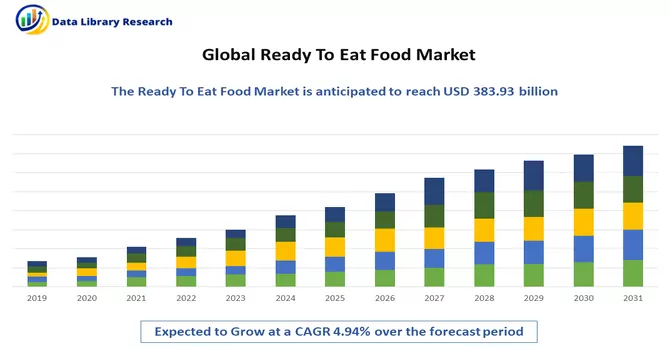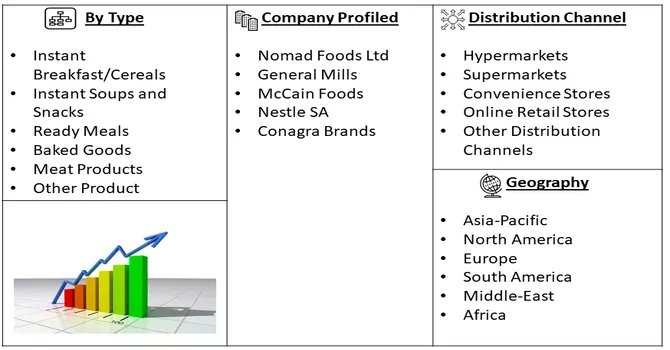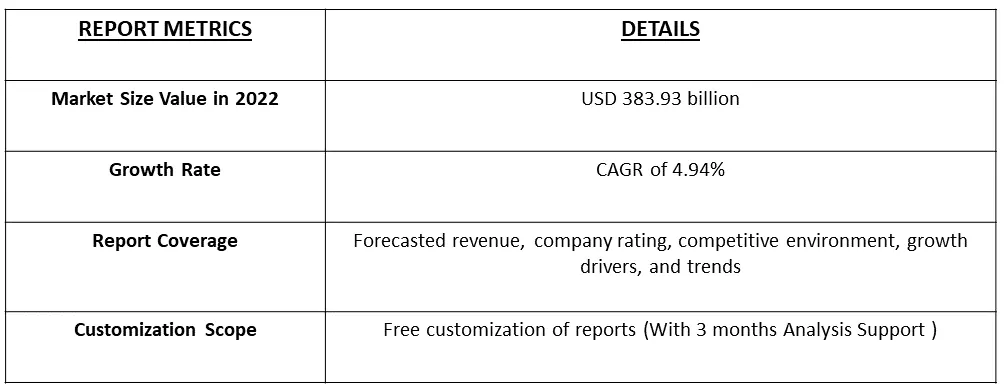The Ready-to-Eat Food Market size is currently valued at USD 383.93 billion in 2022 and is expected to register a CAGR of 4.94% during the forecast period (2023-2030).

Get Complete Analysis Of The Report - Download Free Sample PDF
Ready-to-eat food, often abbreviated as RTE food, refers to any food item that is prepared, cooked, or processed in a way that makes it safe and convenient for consumption without any further cooking or preparation. These foods are fully cooked or processed to the point where they can be eaten directly from their packaging, without the need for additional cooking, heating, or assembly. Ready-to-eat foods are typically pre-packaged, and they come in various forms, including canned, frozen, refrigerated, or shelf-stable products.
The market is undergoing a transformation in consumer choices, with a noticeable shift from homemade meals to ready-to-eat products. This transition is primarily attributed to the fast-paced lives and demanding work schedules of individuals. It is expected that this evolving consumer behavior will substantially boost the market in the forecasted period. Ready-to-eat products are viewed as the most convenient alternative to traditional meals and can be enjoyed at any mealtime, be it breakfast, lunch, or dinner.
The ready-to-eat food industry is continually adapting to meet the evolving preferences of consumers. This includes a focus on health, diversity in flavors, sustainability, customization, and innovative packaging solutions. As consumer demands and expectations change, the industry is likely to see even more exciting developments in the near future. Moreover, ready-to-eat foods are exploring a broader range of international and ethnic flavors. Consumers are showing a growing interest in diverse cuisines, and manufacturers are responding by offering a wider variety of global dishes, from Thai and Indian to Mexican and Mediterranean, providing a culinary adventure in a convenient package. Thus, the market is expected to witness significant growth over the forecast period.
Market Segmentation:
The Global Ready-to-Eat Meals Market is segmented
By Product Type :
Distribution Channel :
Geography :
The report offers the market size and values in (USD Million) during the forecasted years for the above segments.

For Detailed Market Segmentation - Download Free Sample PDF
Market Drivers :
Growing Working Individuals' Busy Lifestyles and Hectic Work Schedules
The escalation of busy lifestyles and hectic work schedules is a hallmark of the contemporary working world. While these changes have led to increased economic productivity and technological advancements, they also pose significant challenges to the well-being of individuals. Finding a balance between work and personal life, practicing effective time management, and prioritizing self-care are crucial steps to mitigate the adverse effects of this fast-paced lifestyle. Understanding and addressing the impact of busy lives and work schedules on individuals and society is essential for creating a healthier and more sustainable work environment. Thus, due to the above-mentioned reasons the market is expected to witness significant growth over the forecast period.
Growing Consumer Interest in New Products and Ingredients
Consumer interest in new products and innovative ingredients within the ready-to-eat food sector reflects a changing landscape of preferences and priorities. With a focus on convenience, health, sustainability, and global flavors, the industry is evolving to cater to a diverse array of tastes and dietary requirements. The market's ability to continually innovate and meet these evolving demands will be crucial in satisfying the appetite of today's discerning consumers. Thus, the market is expected to witness significant growth over the forecast period.
Market Restraints:
High Use of Preservatives May Cause Health-Related Issues
The use of preservatives in the ready-to-eat food market is a double-edged sword. While they play a critical role in ensuring product safety and shelf stability, concerns about their potential health-related impacts are influencing consumer choices. As a result, the growth of the market may slow down over the forecast period.
COVID-19 profoundly impacted the ready-to-eat food market, creating both challenges and opportunities. The surge in demand, shift in consumer behavior, focus on health and wellness, and the need for adaptation and innovation have reshaped the industry. As the world moves towards a post-pandemic era, the market is likely to retain some of these changes while addressing evolving consumer preferences and concerns. The pandemic served as a catalyst for transformation in the ready-to-eat food sector, making it more resilient and responsive to consumer needs. In the current scenario, due to the ease and availability of ready-to-eat food products, the market is expected to witness significant growth over the forecast period.
Segmental Analysis:
Instant Breakfast/Cereals Segment is Expected to Witness Significant Growth Over the Forecast Period Instant breakfast/cereals and ready-to-eat food products have become staples in the modern diet, offering convenience, variety, and nutritional value. These food categories cater to different meal occasions and preferences, providing consumers with quick and hassle-free options in a fast-paced world. The continued innovation in packaging, health-conscious options, and diverse cuisines ensures that these products remain relevant and appealing to a wide range of consumers. Thus, the segment is expected to witness significant growth over the forecast period.
Hypermarkets/Supermarkets Segment is Expected to Witness Significant Growth Over the Forecast Period
Hypermarkets and supermarkets are integral to the ready-to-eat food product market, offering consumers a diverse selection of convenient meal options. Their influence extends to consumer purchasing behaviors, product visibility, and market expansion. As consumer preferences evolve to prioritize health and convenience, these retail giants are likely to continue adapting to meet changing needs and preferences in the dynamic ready-to-eat food market. As a result, the segment is expected to witness significant growth over the forecast period.
Asia-Pacific Region is Expected to Witness Significant Growth Over the Forecast Period
The Asia-Pacific region's ready-to-eat food market's dominance is underpinned by the growing demand for convenient meal options, the introduction of diverse products, and evolving consumer preferences. China and India are key drivers of this growth, with chilled and frozen ready meals being particularly favored. The embrace of vegan, gluten-free, and sustainable packaging options underscores the market's adaptability to changing consumer needs. As the market continues to evolve, strategic measures by industry players will further fuel its expansion and diversification.
Furthermore, the recent developments by key market players are expected to drive the growth of the studied market. For instance, For instance, in February 2022, VegaBytz introduced their plant-based, 100% vegan meat products in India. Meat/Chicken/Tuna ready-to-eat meals and curry products are all vegan and made entirely from plants in the VegaBytz product line. In addition, companies operating in the market are focusing on adopting strategic measures to achieve a strong foothold in these countries, driving market growth.

Get Complete Analysis Of The Report - Download Free Sample PDF
High industrial profitability has led manufacturers to develop powerful competitive strategies, intensifying competition among the existing market players. Major market players are undertaking product innovation, product launches, mergers and acquisitions, geographic expansion, etc., as part of key strategies to remain competitive in the market. Companies are also positioning their products on different factors, including product offerings, quality, taste, flavors, price, functionality, size, packaging, and marketing activities, to gain a competitive advantage in the market. The global ready-to-eat food market is highly competitive, with the presence of key players operating in the market, such as
Key Players :
Recent Developments:
1) In September 2022, McCain Foods acquired Netherlands-based Scelta Products. This acquisition will strengthen the position of the company in prepared frozen appetizers and will add innovation and capacity to frozen appetizers.
2) In August 2022, General Mills Inc. launched prepared meal kits under the brands of Betty Crocker, Old El Paso, Pillsbury, and Annie's Organic brands. It provides consumers with fully prepared, and ready-to-eat meal options for simple homemade dishes.
Q1. What is the current Ready to Eat Food Market size?
The Ready-to-Eat Food Market size is currently valued at USD 383.93 billion.
Q2. What is the Growth Rate of the Ready-to-Eat Food Market?
Ready-to-Eat Food Market is expected to register a CAGR of 4.94% during the forecast period.
Q3. What are the Growth Drivers of the Ready-to-Eat Food Market?
Growing Working Individuals' Busy Lifestyles and Hectic Work Schedules and Growing Consumer Interest in New Products and Ingredients are the Growth Drivers of the Ready-to-Eat Food Market.
Q4. Which Region is expected to hold the highest Market share?
Asia-Pacific region is expected to hold the highest Market share.
Data Library Research are conducted by industry experts who offer insight on industry structure, market segmentations technology assessment and competitive landscape (CL), and penetration, as well as on emerging trends. Their analysis is based on primary interviews (~ 80%) and secondary research (~ 20%) as well as years of professional expertise in their respective industries. Adding to this, by analysing historical trends and current market positions, our analysts predict where the market will be headed for the next five years. Furthermore, the varying trends of segment & categories geographically presented are also studied and the estimated based on the primary & secondary research.
In this particular report from the supply side Data Library Research has conducted primary surveys (interviews) with the key level executives (VP, CEO’s, Marketing Director, Business Development Manager and SOFT) of the companies that active & prominent as well as the midsized organization
FIGURE 1: DLR RESEARH PROCESS

Extensive primary research was conducted to gain a deeper insight of the market and industry performance. The analysis is based on both primary and secondary research as well as years of professional expertise in the respective industries.
In addition to analysing current and historical trends, our analysts predict where the market is headed over the next five years.
It varies by segment for these categories geographically presented in the list of market tables. Speaking about this particular report we have conducted primary surveys (interviews) with the key level executives (VP, CEO’s, Marketing Director, Business Development Manager and many more) of the major players active in the market.
Secondary ResearchSecondary research was mainly used to collect and identify information useful for the extensive, technical, market-oriented, and Friend’s study of the Global Extra Neutral Alcohol. It was also used to obtain key information about major players, market classification and segmentation according to the industry trends, geographical markets, and developments related to the market and technology perspectives. For this study, analysts have gathered information from various credible sources, such as annual reports, sec filings, journals, white papers, SOFT presentations, and company web sites.
Market Size EstimationBoth, top-down and bottom-up approaches were used to estimate and validate the size of the Global market and to estimate the size of various other dependent submarkets in the overall Extra Neutral Alcohol. The key players in the market were identified through secondary research and their market contributions in the respective geographies were determined through primary and secondary research.
Forecast Model
